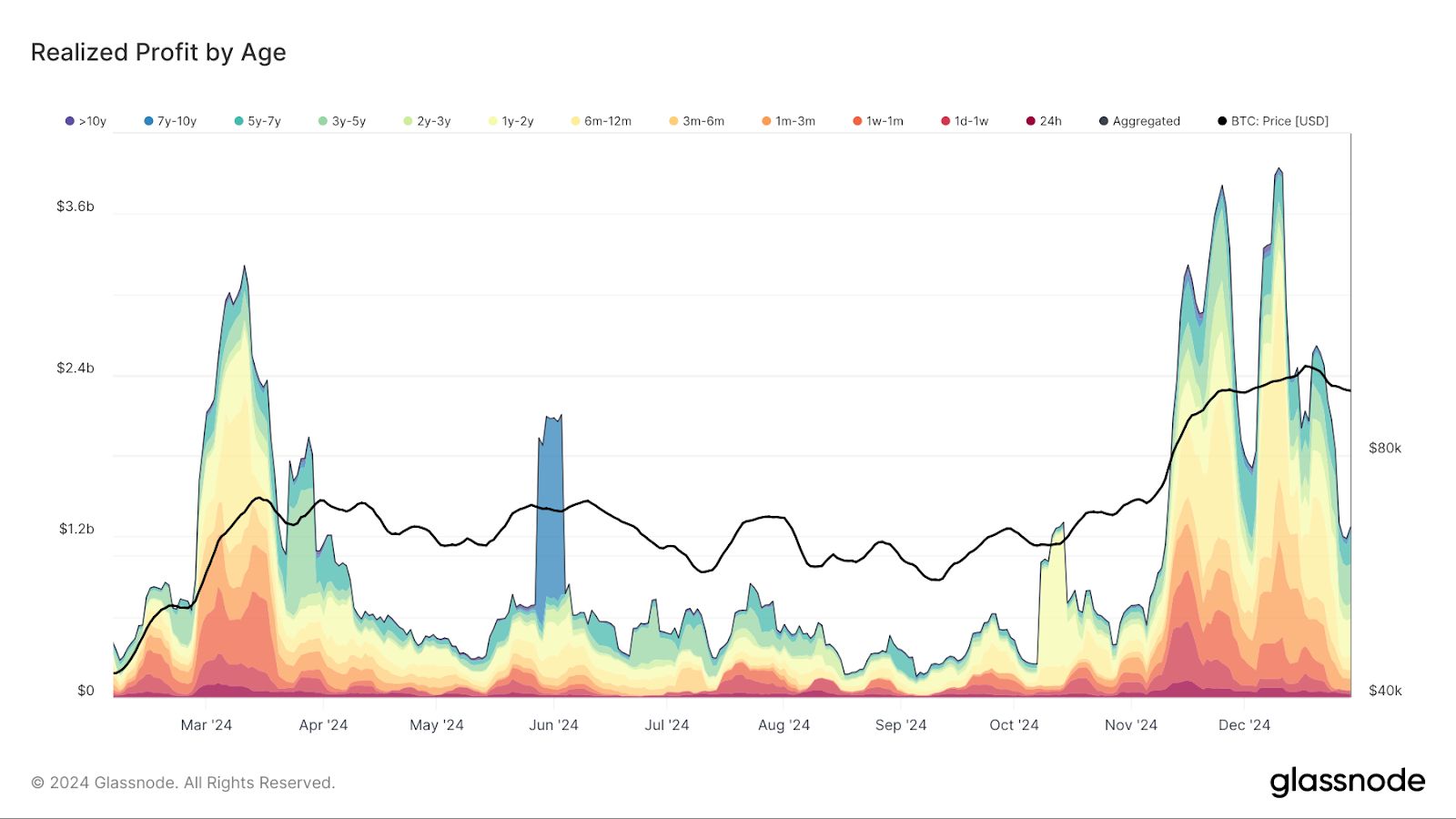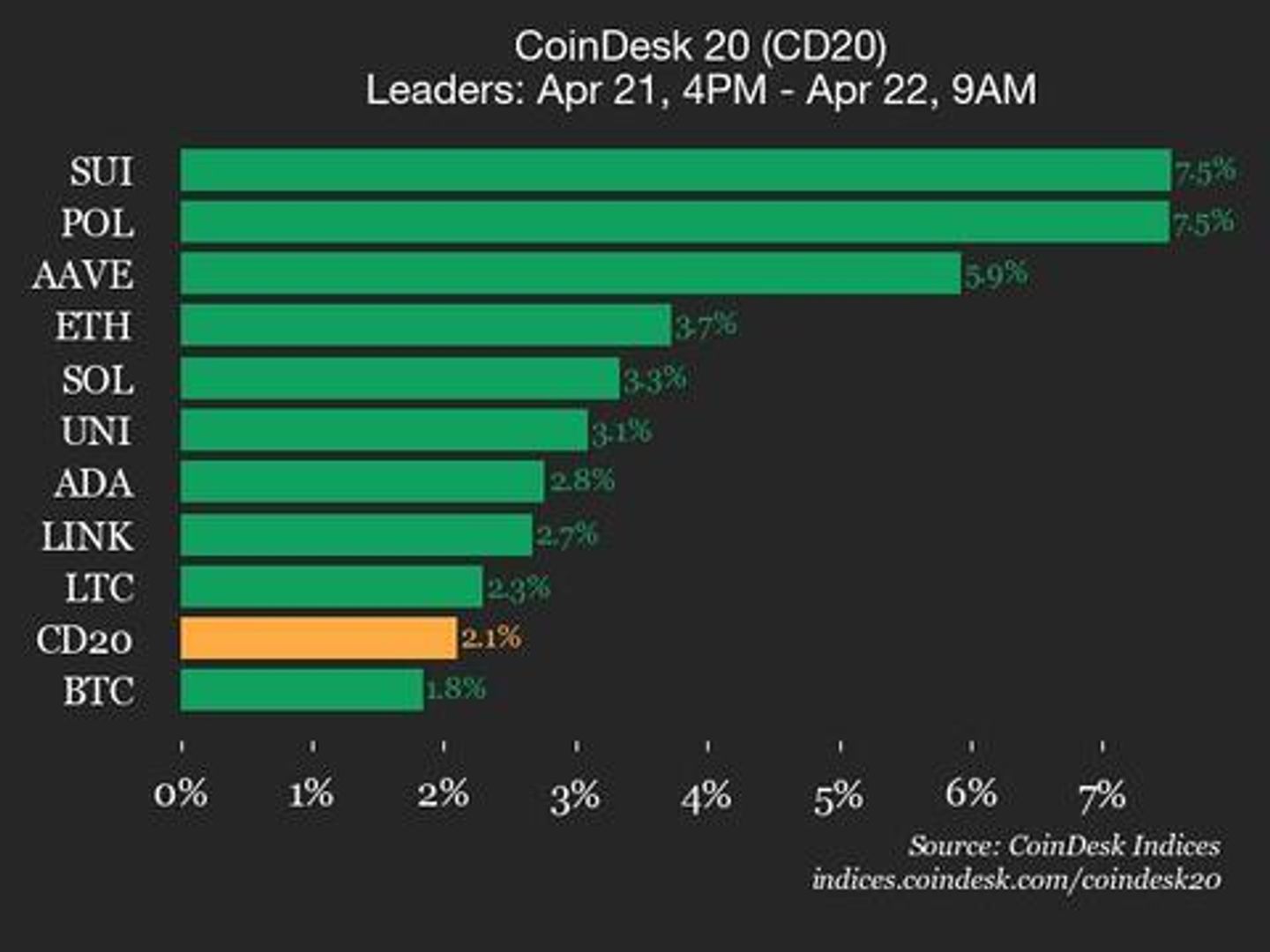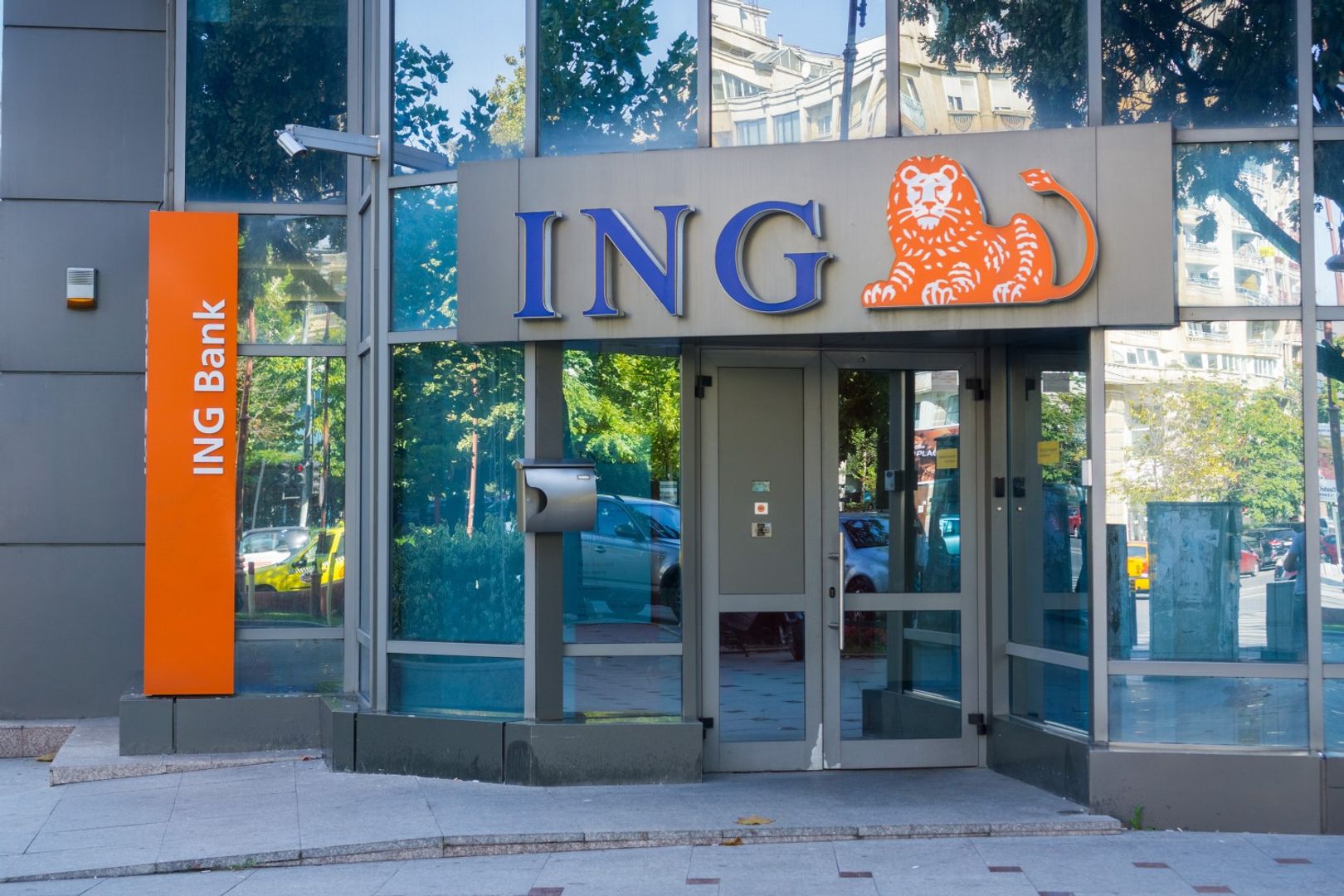Uncategorized
Bitcoin Drops to $92,000 as Long-Term Holders Keep Taking Profit

Crypto prices are experiencing a rocky Monday due to poor U.S. macroeconomic data and rampant profit-taking.
Bitcoin (BTC) has dropped 1.8% in the past 24 hours to $91,800, a price not seen since Dec. 5, the day it broke through $100,000 for the first time. The largest cryptocurrency has fallen more than 14% from its Dec. 17 record of $108,278.
Ether (ETH) has lost less, falling 0.7% to $3,320, though it’s now 17% below its December highs, and still has not surpassed the record $4,820 it hit in 2021. Solana (SOL) is also proving a little stronger than bitcoin, with the SOL/BTC ratio up 0.35% today.
The CoinDesk 20 — an index of the top 20 cryptocurrencies by market capitalization, excluding stablecoins, memecoins and exchange coins — is also in the red, sliding 3.74%. Ripple (XRP) and Stellar (XRM) have taken the biggest hits, down 6% and 6.3% respectively, while the most resilient coin besides ether has been litecoin (LTC), which is 1.9% lower.
Stocks of crypto-related companies also took a hit. MicroStrategy (MSTR) and Coinbase (COIN) fell 7% and 5.3%, respectively and major bitcoin mining firms like MARA Holdings (MARA) and Riot Platforms (RIOT) have dropped more than 7%.
The selling pressure is partially caused by investors cashing out after bitcoin shot up more than 117% this year. Profit-taking currently exceeds $1.2 billion on a seven-day moving average, and while that is significantly less than the Dec. 11 peak of $4.0 billion, it’s still much more than usual. Additionally, the lion’s share of profits is being taken by investors who have held bitcoin for many years.

Macroeconomics are also weighing on the market, with the U.S. Chicago PMI — which measures the performance of the manufacturing and non-manufacturing sector in the Chicago area — flashing its lowest reading since May, suggesting an economic slowdown is underway.
Uncertainty around the Federal Reserve’s interest-rate policy going into 2025 isn’t helping, since the U.S. central bank has signaled it will pause rate cuts until at least March. The inauguration of President-elect Donald Trump, slated for Jan. 20, may also be playing a role. The S&P 500, Nasdaq, and Dow Jones are down more than 1%.
«The market exceeded expectations in 2024, but signs of exhaustion signaled the need for consolidation,» Joe Carlasare, partner at Amundsen Davis, told CoinDesk. «Looking ahead to 2025, I’m optimistic but expect the path to diverge from consensus, as markets often do. Bitcoin’s adoption continues to grow, and I anticipate it will generally move in line with traditional markets. If the U.S. avoids a significant growth slowdown, bitcoin should perform well, though the ride may be bumpier than in 2024.»
Uncategorized
CoinDesk 20 Performance Update: SUI and POL Rise 7.5%, Leading Index Higher

CoinDesk Indices presents its daily market update, highlighting the performance of leaders and laggards in the CoinDesk 20 Index.
The CoinDesk 20 is currently trading at 2556.62, up 2.1% (+52.39) since 4 p.m. ET on Monday.
Fifteen of 20 assets are trading higher.

Leaders: SUI (+7.5%) and POL (+7.5%).
Laggards: FIL (-4.5%) and XLM (-1.6%).
The CoinDesk 20 is a broad-based index traded on multiple platforms in several regions globally.
Uncategorized
DAO Infrastructure Provider Tally Raises $8M to Scale On-Chain Governance

Tally, a leader in on-chain governance tooling, has secured $8 million in Series A funding aimed at scaling its governance technology to more crypto-native decentralized autonomous organizations (DAOs).
Tally is best known for the Tally Protocol, which powers infrastructure to help leading protocols conduct effective on-chain governance of their DAOs, including Arbitrum, Uniswap DAO, ZKsync, Wormhole, Eigenlayer, Obol and Hyperlane.
«We’ve built this complete stack of software for operating these on-chain organizations,» Dennison Bertram, CEO and co-founder of Tally Protocol, said in an interview with CoinDesk. «We can take you from your idea to launching your token, to distributing your membership or ownership, all the way to the value accrual for your protocol.»
The platform began as a DAO governance tool and has evolved into the most widely adopted software stack for on-chain organizations across the Ethereum and Solana blockchains, it said in a release.
«On-chain governance and capital formation could, in theory, dramatically reduce the complexity and cost of forming and operating organizations by moving these processes entirely into software rather than traditional jurisdictions guided by platforms like Tally,» Bertram said.
One day, on-chain organizations might be seen as a way to compete with nation states, he argued, referencing the costly and lawyer-intensive process of registering foundations and other legal entities typically used for crypto.
«Whoever embraces crypto really fully might actually be embracing fully the future,» he said.
Fixing vote turnout for better governance
One issue that Tally aims to tackle with funding from the Series A is low voter participation and apathy in DAO governance, which has led to sometimes controversial outcomes.
Last year, for example, a group of CompoundDAO token holders, called Golden Boys, successfully passed a controversial proposal to create a yield-bearing product called goldCOMP.
Despite initially gaining traction, the proposal faced significant controversy due to perceived irregularities, low voter turnout and a lack of widespread community engagement.
Ultimately, the Golden Boys agreed to cancel goldCOMP, which highlighted the broader issue of governance apathy within DAOs rather than any technical exploit or malicious intent.
«Many of the people that you should expect to vote ‘no’ on something like this didn’t show up,» Bertram said in an earlier interview. «What it shows is that the democratic process of governing a DAO is imperfect and needs improvement.»
To address this, Tally has developed staking mechanisms designed to reward active governance participants economically. Users can stake their governance tokens to receive Tally Liquid Staked Tokens (tLSTs), earning passive, auto-compounding yields while retaining voting rights within DAOs.
“This fundraise is really about leaning into the original vision,” Bertram said. “Now that we’ve proven that this works, that you can have these large organizations, it’s time to really scale it up.”
Institutions are getting involved in DAOs
Bertram also emphasized that recent regulatory clarity and shifts in attitude toward crypto governance in the U.S. have opened the door for increased institutional participation in DAOs.
“With this clarity, we’re going to get a lot more participation, not necessarily from average Joe token holders, but actually from large organizations that depend on the infrastructure they’re building on,” he said. “These organizations are going to need and want the ability to actually govern the infrastructure that they operate on.”
Ultimately, Bertram sees Tally’s role as pivotal in advancing decentralized governance and unlocking greater economic value for token holders by directly rewarding active, informed participants.
«Given the new acceptance of crypto as a key driver of future value in America, it’s time to scale it beyond crypto and make it a core primitive for creating new organizations,” he said.
The round was led by Appworks and Blockchain Capital with participation from BitGo amongst others.
Tally previously raised $7.5 million in 2021 across two funding rounds.
Uncategorized
Dutch Bank ING Said to Be Working on a New Stablecoin With Other TradFi and Crypto Firms

Dutch bank ING is working on a stablecoin, looking to take advantage of Europe’s new cryptocurrency regulations that came into force last year, according to two people with knowledge of the plans.
ING’s stablecoin project could take the form of a consortium effort involving other banks and crypto service providers, both people said.
“ING is working on a stablecoin project with a few other banks. It’s moving slow as multiple banks need board approval to set up a joint entity,” one of the sources said.
ING declined to comment.
Europe’s Markets in Crypto Assets regime [MiCA] requires stablecoin issuers across EU member countries to hold an authorization license, while promoting the potential of euro-denominated stablecoins (the vast majority of the stablecoins in circulation are pegged to the U.S. dollar).
MiCA’s stablecoin rules, which also require issuers to maintain significant reserves in banks based in Europe, have strengthened compliant offerings like Circle’s euro stablecoin EURC over its main rival Tether, according to a note early this year from JPMorgan.
Banks like ING entering the European stablecoin space means French lender Société Générale, the first big bank to offer a stablecoin through its SG Forge innovation division, will soon have some competition.
Read more: Stablecoin Market Could Grow to $2T by End-2028: Standard Chartered
-

 Fashion6 месяцев ago
Fashion6 месяцев agoThese \’90s fashion trends are making a comeback in 2017
-

 Entertainment6 месяцев ago
Entertainment6 месяцев agoThe final 6 \’Game of Thrones\’ episodes might feel like a full season
-

 Fashion6 месяцев ago
Fashion6 месяцев agoAccording to Dior Couture, this taboo fashion accessory is back
-

 Entertainment6 месяцев ago
Entertainment6 месяцев agoThe old and New Edition cast comes together to perform
-

 Sports6 месяцев ago
Sports6 месяцев agoPhillies\’ Aaron Altherr makes mind-boggling barehanded play
-

 Business6 месяцев ago
Business6 месяцев agoUber and Lyft are finally available in all of New York State
-

 Entertainment6 месяцев ago
Entertainment6 месяцев agoDisney\’s live-action Aladdin finally finds its stars
-

 Sports6 месяцев ago
Sports6 месяцев agoSteph Curry finally got the contract he deserves from the Warriors





